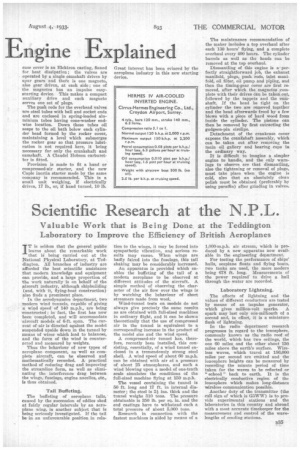Scientific esearch at the N.P.L.
Page 45

If you've noticed an error in this article please click here to report it so we can fix it.
Valuable Work that is Being Done at the Tealdington Laboratory to Improve the Efficiency of gritish Aeroplanes
IT is seldom that the general public learns about the remarkable work that id being carried out at the National Physical Laboratory, at Teddington. All branches of industry are afforded the best scientific assistance that modern knowledge and equipment can provide, and a large proportion of the work naturally is on behalf of the aircraft industry, although shipbuilding (and, with it, flying-boat construction) also finds a prominent place.
In the aerodynamics department, two modern wind tunnels capable of giving a wind speed of 140 m.p.h., are being constructed ; in fact, the first has now been completed, and will accommodate aircraft models of 6-ft. span. The current of air is directed against the model suspended upside down in the tunnel by means of wires which lead to balances, and •the force of the wind is counteracted and measured by weights.
Thus the behaviour of new types of aeroplane component, as well as cornplett aircraft, can he observed and mathematically recorded. A practical method of reducing drag and improving the streamline form, as well as eliminating the, interference drag between the wings, fuselage, engine nacelles, etc., is thus obtained.
Tail Buffeting.
The buffeting of aeroplane tails," caused by the succession of eddies shed at fairly regular intervals by an aeroplane wing, is another subject that is being seriously investigated. If the tail be in an unfavourable position in rela
tion to the wings, it may be forced into sympathetic vibration, and serious results may ensue. When wings are badly faired into the fuselage, this tail shaking may be considerably increased.
An apparatus is provided which enables the buffeting of the tail of a modern aeroplane to be observed at different attitudes of the aircraft. A simple method of observing the character of the air flow over the wings is by watching the behaviour of short streamers made from wool.
Wind-tunnel tests on models do not always give precisely the same results as are obtained with full-sized machines in ordinary flight, and it can be shown theoretically that the use of compressed air in the tunnel is equivalent to a corresponding increase in the product of the model size and the wind speed.
A compressed-air tunnel has, therefore, recently been installed, this consisting, essentially, of a wind tunnel enclosed in a tremendously strong steel shell. A wind speed of about 60 m.p.h. can he obtained with air at a pressure of about 25 atmospheres, and such a wind blowing upon a model of one-tenth scale simulates the conditions of the full-sized machine flying at 150 m.p.h.
The vessel containing the tunnel is 50 ft. long and 17 ft. in internal diameter; the steel is 24 ins, thick and the tunnel weighs 310 tons. The pressure obtainable is 350 lb. per sq. in. and the end castings have to withstand each a total pressure of about 5,000 tons.
Research in connection with the fastest machines is aided by means of a 1,000-m.p.h. air stream, which is produced by a new apparatus now available in the engineering department.
For testing the performance of ships' hulls, seaplane floats and flying boats, two tanks are used, the more modern being 678 ft. long. Measurements of the power requiredto drive a hull through the water are recorded.
Laboratory Lightning.
The effects of lightning and the values of different conductors are tested by means of an impulse generator, which gives million-volt sparks. A spark may last only one-millionth of a second and, in effect, it is a miniature flash of lightning.
In the radio department research progresses in regard to the ionosphere, commonly known as the radio roof of the world, which has two ceilings, the one 60 miles and the other about 130 miles above the earth's surface. Wireless waves, which travel at 186,000 miles per second are emitted and the ionosphere heights can be measured by recording the minute period of time taken for the waves to be reflected or " echoed" back to earth. It is the electrically conductive region of the ionosphere which makes long-distance wireless communication possible.
Another duty of the transmitter (the call sign of which is G5WW) is to provide experimental stations and the laboratories in this country and abroad with a most accurate timekeeper for the measurement and control of the wavelengths of sending stations.




















































































